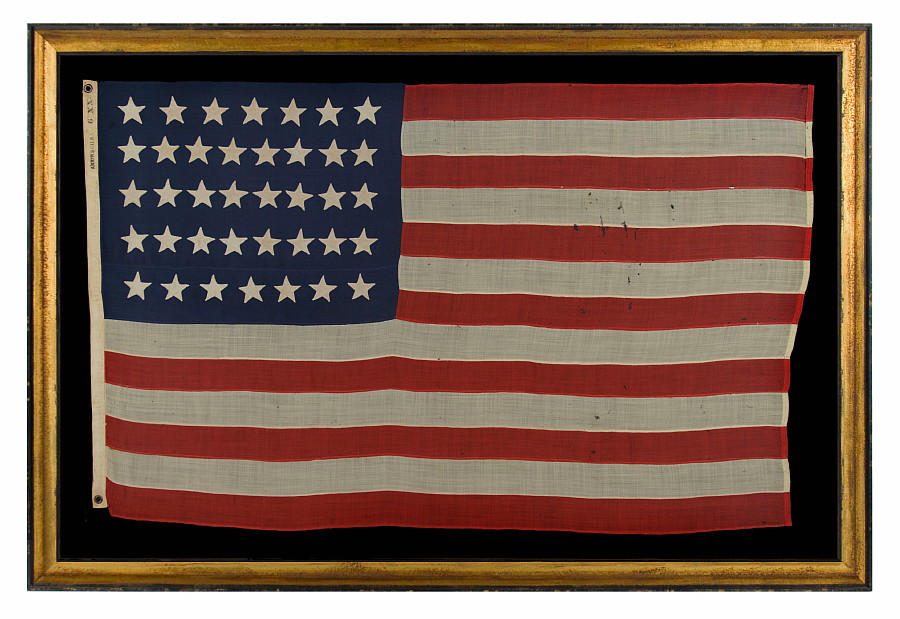
| |
38 HAND-SEWN, SINGLE-APPLIQUED STARS ON A FLAG IN A VERY DESIRABLE SMALL SCALE FOR THE PERIOD, MADE BY ANNIN IN NEW YORK CITY, 1876-1889, COLORADO STATEHOOD |
|
| Available: |
Sold |
| Frame Size (H x L): |
54.75" x 80.75" |
| Flag Size (H x L): |
43.5" x 69.5" |
|
| Description....: |
|
38 HAND-SEWN, SINGLE-APPLIQUED STARS ON A FLAG IN A VERY DESIRABLE SMALL SCALE FOR THE PERIOD, MADE BY ANNIN IN NEW YORK CITY, 1876-1889, COLORADO STATEHOOD:
38 star American national flag in a desirable, small size for the period (1876-1889). The stars are made of cotton, hand-sewn, and single-appliqued. This means that they were applied to one side of the canton, then the blue fabric was cut from behind each star, folded over, and under-hemmed, so that one star could be viewed on both sides of the flag. I always find single-appliqued stars more interesting, not only because they are evidence of a more difficult level of seam-work and stitching, but also because they are more visually intriguing. Both the sewing itself and stretching of the fabrics over time has results in stars that have irregular shapes and interesting visual qualities, which is why flags with single-appliqued stars often appeal to connoisseurs of early American textiles. The two visible rows of hand-stitching emphasize their hand-sewn construction.
This flag was made by Annin in New York City and is signed with a black stencil along the hoist binding that reads "Annin & Co., N.Y.". Annin is our nation's eldest flag-maker that is still in business today. The company was founded in the 1820's on the New York waterfront, incorporated in 1847, and, though it opened a large manufacturing operation in Verona, New Jersey in 1916, maintained its head office and some production in Manhattan until 1960.
The stripes and canton of the flag are made of wool bunting that has been pieced with treadle stitching, which is typical of the period. The canton is constructed from two lengths of blue fabric, because wool bunting was only available in a maximum width of eighteen inches. There is a twill cotton binding with two brass grommets for hoisting, along which is a blue inked stencil that reads "6 XX" to indicate size.
Adding to the appeal of this flag is its comparably tiny size when compared to others made for extended outdoor use prior to 1890. During the 19th century, flags with pieced and sewn construction (as opposed to printed) were typically eight feet long or larger. This is because they were important in their function as signals, meaning that they needed to be seen and recognized from a great distance. Even flags made for decorative purpose were generally very large by today's standards. A small flag was six feet in length, like this example. Production of flags smaller than this with sewn construction was near-to-non-existent, with the exception of infantry flank-markers and guidons, surviving examples of which are rare. Since the average 19th century sewn flag can be cumbersome to frame and display in an indoor setting, many collectors prefer printed parade flags and smaller sewn flags, like this one.
The 38th state, Colorado, received its statehood on August 1st, 1876. This was the year of our nation's 100-year anniversary of independence. Although 37 was the official star count for the American flag in 1876, flag-making was a competitive venture, and no one wanted to be making 37 star flags when others were making 38's. It is for this reason that 38 and 13 stars (to represent the original 13 colonies) are the two star counts most often seen at the Centennial International Exposition, the six-month long, World's Fair, held in Philadelphia in honor of the event. The 38 star flag became official in 1877 and was generally used until the addition of the Dakotas in 1889.
Mounting: The flag was stitched to 100% silk organza on every seam and throughout the star field for support. It was then sewn to a background of 100% cotton twill, black in color, which was washed to remove excess dye. An acid-free agent was added to the wash to further set the dye and the fabric was heat-treated for the same purpose. The mount was then placed in a black-painted, hand-gilded and distressed Italian molding. The glazing is U.V. protective acrylic.
Condition: There is minor mothing, but there are no serious condition issues. |
|
|
|
| Collector Level: |
Intermediate-Level Collectors and Special Gifts |
|
| Flag Type: |
Sewn flag |
|
| Star Count: |
38 |
|
| Earliest Date of Origin: |
1876 |
|
| Latest Date of Origin: |
1889 |
|
| State/Affiliation: |
Colorado |
|
| War Association: |
1866-1890 Indian Wars |
|
| Price: |
SOLD |
|
| |
Views: 3459 |
|
|
|

